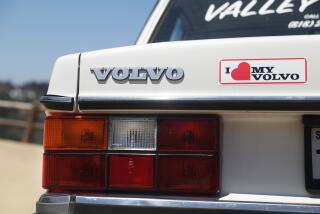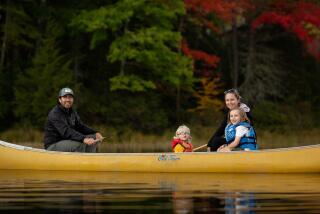For Better or For Worse, the Car Is Still Part of the Family
- Share via
My daughter approaches the black station wagon with the slightly dented passenger side front door and pats the fender fondly. “My car,” she says, as if greeting a pet or a beloved baby doll. And I realize that when my husband and I chose this car a couple of years ago, we were doing more than upgrading from a two-door; we were picking the Family Car.
That is a term well-known by car designers and marketers, flung about in advertisements and trend stories, and for the most part it conjures up “more”--more space, more doors, more seats, more cup holders, more headroom so it is possible to drop a small TV and, heck yeah, maybe a microwave oven down from the roof.
The ads inevitably feature a mom in a Dorothy Hamill ‘do smiling into the rearview mirror at a litter of slumbering or otherwise dreamily focused youngsters.
At their feet, on a floor free of crumbs, shoes and desiccated juice boxes, lie charmingly worn soccer balls, baseball mitts and other accouterment of the perfect childhood.
Music swells and the camera pans back to show a quiet country road cutting through a golden-leaved forest in a place and time that does not exist on this planet.
Which isn’t to say that the Family Car does not exist or that it doesn’t have cultural resonance. Of course it exists; just look at all those smudgy handprints and Power Ranger stickers on windows of car after car you pass on the freeway. And as for resonance, well, in America at least, the Family Car may be the first indication of a culture outside the family that a person gets.
As Fiona, at 2, has just discovered, her car is different from the cars of her little friends, and by the time she hits her brother’s age--a sagacious 4--she will begin to understand that this means something. That the Family Car inevitably betrays quite a bit about its Family.
When I was 7 and got my very own camera, the first thing I did was run around my neighborhood taking pictures of everyone’s cars. My parents thought this a fruitless pursuit but figured I had chosen my subjects because they could neither throw up a protesting palm or move out of the frame.
I still have those pictures, and looking at them, I know exactly what I was doing. To me, these cars were as representative of our neighbors and their ways as their front doors, or their faces.
The Marsons drove an Oldsmobile because he was old and cranky; we had a Ford station wagon because we were a Ford family; the Bossys had a trailer hitch because Mr. Bossy had a boat somewhere.
Our family car changed over the years as our family did. At some point we unloaded the station wagon and Dad got a pickup, but we still needed a car we could all fit in. For one lamentable period it was a lemon yellow Pinto soon followed by an Aztec copper Pacer that looked exactly like an automotive Birkenstock and had a “Jerry Brown for President” bumper sticker.
It was right about this time that my brother and I came into the full awareness of the shame that an embarrassing family car can evoke. These were followed by two Ford Fiestas, orange and yellow, that were unmercifully sturdy and reliable--no matter how much my brother and I abused them, they refused to break down.
Clearly, we were a family with issues. But there these cars all were, nosing their way into our pictures as frequently as our dogs or Christmas trees. For better or for worse, they, like shag carpet and Fair Isle sweaters, were part of who and what we were.
I hadn’t considered any of this when my husband and I picked what would be our children’s first family cars. I think we did OK--the Passat has become a natural Volvo substitute among growing families without $45K to spare, and my husband’s Camry is sleekish and unobjectionable.
But still, we’ll have to be careful in the future--I still remember with fondness the washed-out blue of the station wagon and how hateful the lemon yellow that followed it seemed. As if things were about to go downhill, as if I’d never feel as I did when lying on a blanket in the back of the wagon, listening to the road rippling beneath me and even though the sky was cold and full of snow, I was warm and sleepy.
The Pinto, as I recall, had bucket seats in the back. They were green.
Mary McNamara can be reached at [email protected].







